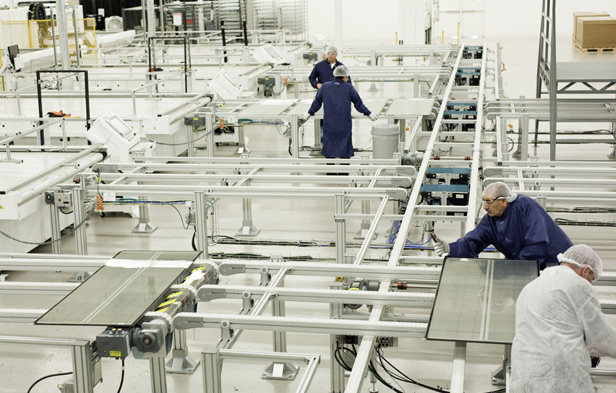Is Thin-Film Solar Dead?

When the Chinese energy giant Hanergy decided last week to buy Miasole, a Silicon Valley-based thin-film solar company, at less than a tenth the amount venture capitalists had invested in the firm, it could have been making a savvy move. Though it seems as if thin-film solar panels have no hope of competing with conventional silicon ones under today’s market conditions, the technology might still have a strong future.
In recent years, the price of conventional silicon solar panels has fallen far faster than expected, and once-promising thin-film startups are going bankrupt, delaying manufacturing plans, or being bought by Asian companies for pennies on the dollar. (In addition to Hanergy, TFG Radiant, SK Innovation, Taiwan Semiconductor, and a few others have bought or taken large stakes in such companies.)
Some analysts think the companies that have been snatching up these bargains know what they’re doing. The poor market conditions that have kept thin-film companies from competing may not last: when demand increases and it comes time to start building solar-panel factories again, the argument goes, the technology might have a significant advantage, because for comparably sized plants, it could cost far less to build a new thin-film factory than a conventional one.
A gigawatt-scale thin-film plant would cost $350 to 450 million, versus $1 billion for a conventional silicon plant, says Travis Bradford, a professor at Columbia University’s school of international and public affairs and president of the Prometheus Institute for Sustainable Development, a nonprofit research firm. (The cost estimates will vary depending on what’s included in the plant. For example, if you add the cost of producing polysilicon, the equivalent to the raw materials that thin-film solar plants use, the capital cost for a silicon plant goes up to $2 billion or more, he says. But most plants buy silicon from large suppliers.)
So far, the companies with the potentially cheapest thin-film technology have built only relatively small factories that cost far more per watt than large ones, and building larger plants doesn’t make sense in the current market. (Solyndra, the failed thin-film company, was building a large plant, but it had notoriously expensive technology, including unusual tube-shaped solar panels. First Solar, by far the most successful thin-film company, has built large plants, but newer types of thin-film technologies may prove cheaper and more efficient.)
Startups can’t afford to wait until market conditions get better. But large companies like Hanergy might be able to bide their time until the market improves and then build a large plant that could compete with conventional silicon (see “How Small Solar Companies Can Survive the Shakeout”). “Hanergy spent $30 million to get Miasole,” Bradford says. “It will take them a few hundred million dollars to eventually build a large factory and launch the technology. But if they’re right, they’ve got assets that will be worth billions of dollars later. That’s the bet they’ve made.”
Waiting for market conditions to turn, however, is a risky strategy. The market is currently flooded with solar panels—current manufacturing capacity is more than enough to satisfy demand, and that’s driven down prices to the point that many manufacturers are selling at a loss. It’s not clear how long it will take for this situation to change. Timing the construction of new thin-film factories will be difficult. In the meantime, manufacturers of conventional silicon technology continue to lower the cost of their solar panels and improve their efficiency. And there’s no guarantee that new thin-film panels will perform as expected when produced at a large scale—or that cost targets will be met.
One option could be for large companies to develop and build their own solar power plants. That’s the model used by First Solar, and it seems to be the model Hanergy is adopting (see “What Happened to First Solar?”).
But many analysts remain skeptical that thin film can compete with silicon, given silicon’s overwhelmingly larger scale of production. Thin film may have had a chance once, but it’s taken it too long to reach large-scale production and lower costs, according to Jenny Chase, manager of the Solar Insight Team at Bloomberg New Energy Finance. “That ship has sailed,” she says. She expects that thin-film companies might succeed only in niche markets, such as applications where very lightweight or flexible solar panels are needed (see “A Solar Startup that Isn’t Afraid of Solyndra’s Ghost”).
Keep Reading
Most Popular
Large language models can do jaw-dropping things. But nobody knows exactly why.
And that's a problem. Figuring it out is one of the biggest scientific puzzles of our time and a crucial step towards controlling more powerful future models.
The problem with plug-in hybrids? Their drivers.
Plug-in hybrids are often sold as a transition to EVs, but new data from Europe shows we’re still underestimating the emissions they produce.
How scientists traced a mysterious covid case back to six toilets
When wastewater surveillance turns into a hunt for a single infected individual, the ethics get tricky.
Google DeepMind’s new generative model makes Super Mario–like games from scratch
Genie learns how to control games by watching hours and hours of video. It could help train next-gen robots too.
Stay connected
Get the latest updates from
MIT Technology Review
Discover special offers, top stories, upcoming events, and more.